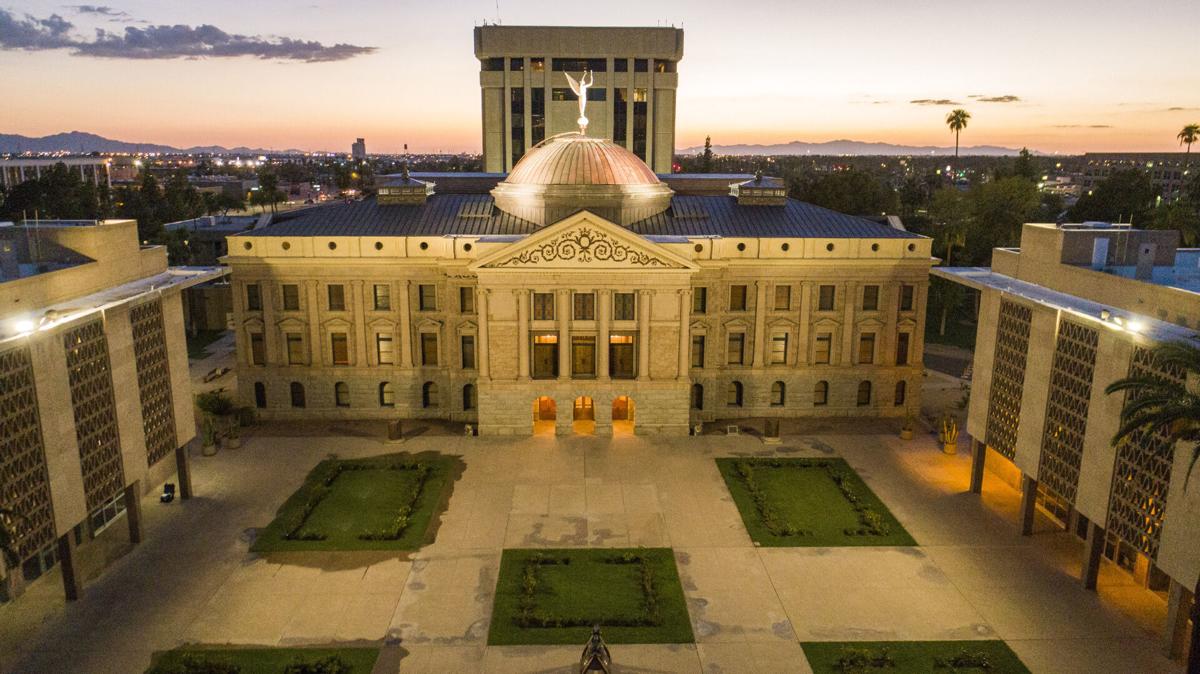PHOENIX — State lawmakers return to the Capitol Monday with an overflowing list of major issues that need to be addressed, from water to housing to the economy.
But first they’ll have to balance a budget with a gaping hole that will require tough choices — and likely cuts to current and future spending plans.
That’s a huge change from the 2023 legislative session, when lawmakers were blessed with the largest budget surplus in state history — more than $2 billion.
Now, the most recent estimates show the state will end the fiscal year on June 30 about $420 million in the red and have $450 million less than is needed in the coming budget year to fund schools, health care, prisons, universities and other state responsibilities. And tax collections in the first six months of the budget year are coming in so far under projections that the current-year deficit could well double.
While there are economic factors that affect state revenues, this budget crunch is mainly self-inflicted, the result of a massive income tax cut majority Republican lawmakers rammed though in 2021 and then-Gov. Doug Ducey enthusiastically signed that mainly benefits wealthy Arizonans.
Also contributing to the shortfall are hundreds of millions of dollars in new spending on a universal school voucher program Ducey also approved.
And unlike what Congress can do, the Arizona Constitution forbids the state from running a deficit.
Tax cuts, vouchers, earmarks
This is a massive turn-around from that $2 billion surplus.
The Legislature’s minority Democrats mainly let Gov. Katie Hobbs take the lead in 2023 to hammer out a budget deal with Republican legislative leaders that corralled — some would say bought — enough GOP votes to pass the $17.8 billion deal.
The elected officials spent virtually all of the surplus, despite knowing the full effects of the tax cuts and vouchers were major unknowns.
The biggest of those special earmarks designed to get GOP votes in last year’s budget deal was a one-time income tax rebate to families with dependents. It provided up to $750 to taxpayers and ultimately cost $266 million.
Another $600 million in special earmarks was designated for highway projects alone, including $89 million to widen a stretch of Interstate 10 between Chandler and Casa Grande.
There also was a $300 million infusion into K-12 schools and a $150 million deposit into the state Housing Trust Fund championed by Hobbs and fellow Democrats.

Winged Victory stands atop the copper dome of the Arizona state capitol building in Phoenix.
There were also some special carve-outs ranging from road improvements and traffic circles and new substations for police and sheriff’s departments to $15.3 million tagged for capital costs at the Prescott Frontier Days Rodeo. The legality of the Prescott earmark remains uncertain and in litigation.
Health-care expenses
And none of this takes into account the other side of the equation: Expenses are ballooning above projections, including expanding enrollment in the state’s Medicaid program, formally called the Arizona Health Care Cost Containment System.
As of Dec. 1, there were more than 1.9 million residents getting all of their care from the state insurance program. Add to that those getting long-term care and partial services and the tally reaches 2.2 million.
That’s close to 30% of the state population.
A decade ago there were about 1.3 million Arizonans enrolled. That was at a time the state population was about 6.6 million, meaning care was being provided to about 20% of those living here.
Add to that a cut in how much the federal government pays, and AHCCCS says it needs an extra $450 million in the coming budget year.
The prison system also just received the OK from lawmakers to boost health care yearly spending by $117 million in response to a federal judge’s ruling that said prisoner care was so bad it violated the U.S. constitution.
So that surplus is now a deficit.
“A cash flow problem”
House Speaker Ben Toma said it’s a transient issue, and that state budget analysts are predicting the current deficit will turn positive in two years.
“It’s really a cash flow problem, more than it is a long-term structural problem,’’ said the Peoria Republican, who championed both the income tax cut and expanded school vouchers. “And that’s the part that I think needs to be communicated to people if we’re going to be honest about this in terms of where we actually are and how we got here.’’
Democrats have a different view, pointing to year after year of permanent tax cuts enacted by Republicans that have left the state with unmet needs.
“So the problem was caused by the Republicans,’’ said Senate Minority Leader Mitzi Epstein.
“It is a revenue problem,’’ said the Tempe Democrat. “It is not an overspending problem. And therefore, it should be looked at with an eye towards what’s wrong with our revenue situation.”
She notes that lower- and middle-income Arizonans pay a far greater percentage of their income in state and local taxes than the wealthy, who benefit the most from the 2021 income tax cuts.
That was by design.
Arizona used to have a graduated tax rate, starting at 2.59% on the first $53,000 of taxable income for a married couple, rising in steps to 4.5% on earnings of more than $318,000.
Ducey pushed through a flat 2.5% tax rate, claiming it was saving the average Arizonan $300 a year.
But the key there is the word “average.’’
Legislative budget staffers figured that 72% of state residents would see a benefit of less than $45. More than half would get a tax break of no more than $17.
The Center for Economic Progress says the net effect of the lower taxes was to reduce state collections by about $2 billion a year from what they would have been.
And while lawmakers anticipated a drop in revenues from the lower tax rates, they did not realize how deep that was going to be.
For November, the most recent figures available, legislative budget staffers say income tax collections were nearly $60 million below the forecast; for the first five months of the fiscal year income tax revenues are $421.5 million below what was used to build the budget.
Slow sales
But it’s not just flat taxes that are taking a toll on revenues. The economy is part of the issue.
The most recent figures show sales tax collections running about $66 million below what was forecast. A lot of that has been fueled by weakness in several retail sectors including vehicle sales, something that is affected by high interest rates to finance purchases.
There also are indications of depressed collections in taxes on furniture and building materials.
All that goes to the question of how to make up the $420 million — or more — deficit for the balance of this fiscal year that ends June 30.
Senate President Warren Petersen offered a simple solution to addressing the budget shortfall.
“We are going to shrink government a little bit,’’ the Gilbert Republican said. “And that’s not a bad thing.’’
The Free Enterprise Club, which successfully sued to block a voter referral seeking to overturn the income tax cuts, argued that bloated government spending provides an opportunity and echoed Toma’s take on the size of the shortfall.
“As long as the Legislature: 1) doesn’t allow Hobbs to use any budget gimmicks like rollovers, 2) doesn’t touch the rainy-day fund, and 3) uses this an opportunity to right size government, we will be just fine,’’ the conservative group said in a blog post.
Where to cut spending?
Neither Petersen nor Toma offered any specific suggestions on where to cut spending.
Sen. John Kavanagh, R-Fountain Hills, who chairs the Senate Appropriations Committee, said the immediate shortfall can be handled by delaying some of the projects that were funded as part of the budget year. He said many simply aren’t yet ready, including the I-10 widening.
Toma echoed that sentiment in an interview with Capitol Media Services.
“There is opportunity for us to delay some of those, reprioritize some of those monies, which will get us through what is a short-term problem from a budget standpoint,’’ he said.
Epstein, however, said the answer is new revenues.
One possibility, she said, is higher taxes on the state’s new sports gambling businesses.
All the state’s major sports franchises were awarded licenses by Arizona to take wagers on professional and college games two years ago.
But that 2021 deal, negotiated by Ducey, requires them to pay just 10% of their net profits in state taxes. In October alone, the teams raked in $320 million after federal taxes; they paid $32 million to the state.
But Epstein had no answers when asked how to get GOP lawmakers to change philosophies and consider bringing in more cash. “Do you have a magic wand?’’ she quipped.
“You just got to look at this and stop just saying we’re overspending,’’ Epstein said. “We have to help the people of Arizona understand that we have had enormous cuts to revenue over time, over the past 30 years. It’s been cut, cut every year.’’
And Epstein said lawmakers need to understand the implications of such actions.
“It’s going to hurt a lot of people unless we can come up with a better way to handle both sides of our budget, revenue and spending, and make sure we’re looking out for the people of Arizona that they can still put on their tables a bountiful lunch,’’ she said.
Then there’s the fact that the largest sections of the state budget — the places where cuts could make a big difference — are pretty much immune. That includes AHCCCS, which commands $2.5 billion of the nearly $17.9 billion budget, and the prison system, which costs nearly $1.5 billion.
Funding schools
Eclipsing both of those is state aid to K-12 schools, which comes in at almost $7.8 billion.
But Rep. David Livingston, R-Peoria, said even if public education could be cut, such a plan is not on the table. Livingston, who chairs the House Health Committee, noted that school spending has finally rebounded from the last recession.
What also is not on the GOP agenda is a proposal by the governor to limit vouchers — known as Empowerment Scholarship Accounts — to students that had attended public schools.
A 2022 change in state law makes vouchers of at least $7,300 available to any student. That resulted in a rush of new sign-ups, many from students who already were in private and parochial schools with their parents picking up the tab. Hobbs, in seeking to pare it back, said that has ballooned costs of the program to nearly $1 billion.
Limiting vouchers isn’t going to happen, Toma said.
“I don’t know what else I can say or how much more blunt I can be on this,’’ he said. “ESAs are here to stay, they’re not going to get capped.’’
And Petersen called any claim that the vouchers are part of the reason for the deficit “complete baloney.’’
“We have a K-12 budget and we are within that budget,’’ he said. “ESAs fall within that number.’’
Get your morning recap of today's local news and read the full stories here: tucne.ws/morning






